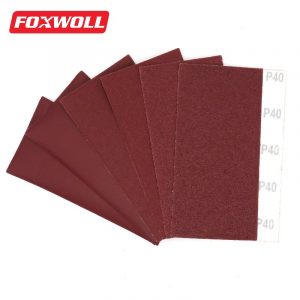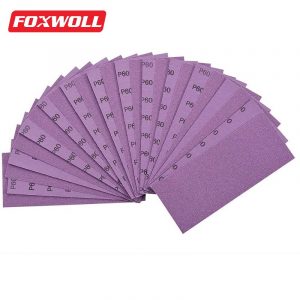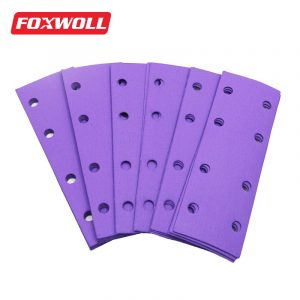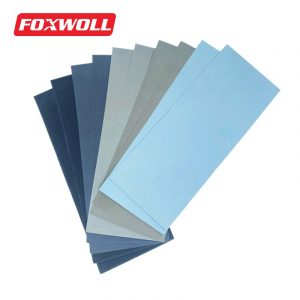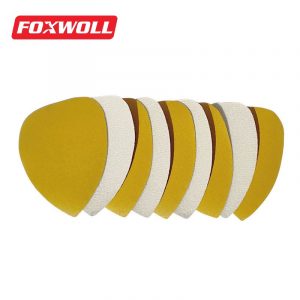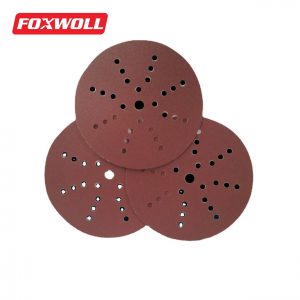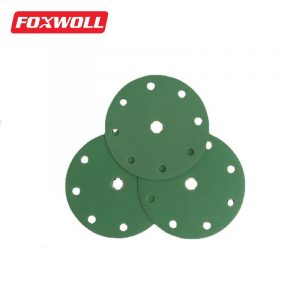Sandpaper Suppliers
Waterproof and tensile technology makes these abrasive paper sheets sturdy and long-lasting, wet or dry.
Able to handle a variety of jobs and minor repairs, it is very practical.
The softback design ensures a good grip and smooth polishing of items with just a little effort without slipping or loosening.
Satisfy most daily use, suitable for metal, automobile, woodworking, plastic, handicraft, resin, glass, etc. for polishing.
Provide You With A One-stop Sandpaper Shopping Platform
As professional sandpaper manufacturers, FOXWOLL offers a wide variety of sandpapers for a variety of industry applications, including woodworking, metalworking, automotive, marine as well as granite, and marble, to meet most of your needs.
Can't Find The Sandpaper You Need? Contact Our Product Advisor For The Latest Catalog
Why Choose FOXWOLL as Your Sandpaper Suppliers?
Manufactured from aluminum oxide and silicon carbide and available in a variety of particle sizes, FOXWOLL sandpaper products have the unique ability to provide excellent abrasive life while leaving a consistent scratch pattern. Our sandpapers are available in plain, PSA, and Velcro backings that can be attached to any handheld sander. Order sandpaper at FOXWOLL and we can promise you:
Strict Quality Control
We have a strict quality control system. Our products and manufacturing processes are constantly tested. This includes regularly inspecting our product batches and documenting the results.
Competitive Price Advantage
Price has always been a strong competitive advantage for FOXWOLL. Engaged in trade for many years, we have been committed to helping more customers obtain greater benefits and create greater value for them.
Professional Sales Team
We have a professional sales team that can provide you with professional consultation and solutions. If you have any questions, please feel free to contact us, we have professional staff 24 hours online one-to-one service.
Huge Inventory
With our strong manufacturing facilities and warehouse inventory, we can assure you that we will continue to provide you with sufficient product resources. So you don’t have to worry about delivery.
Our Areas of Application

Leather and Rubber Industry
Leather and rubber are very demanding materials for polishing and sanding operations, and FOXWOLL has been developing higher quality products to meet their needs over the years.
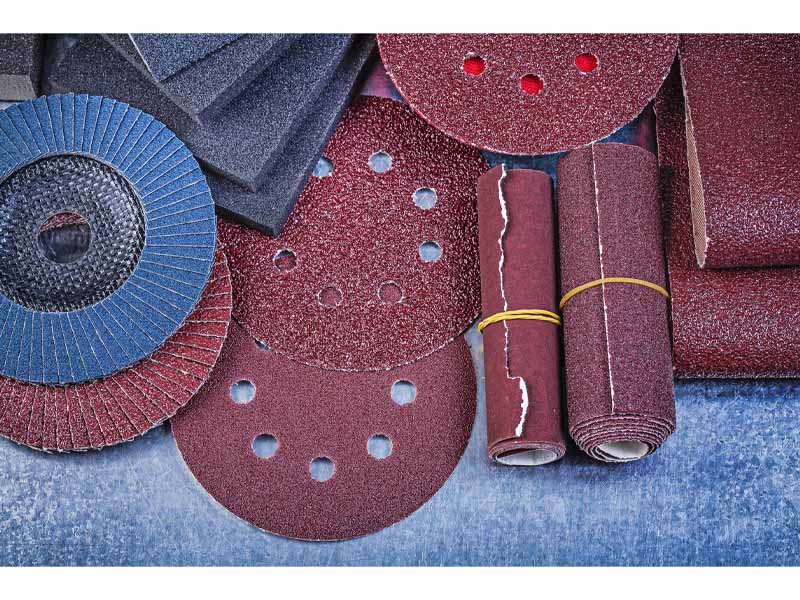
Metal Industry
Metals are the foundational material for countless industries, and as the market demand for high-value metals continues to increase, we offer efficient and up-to-date products for a great grinding experience.
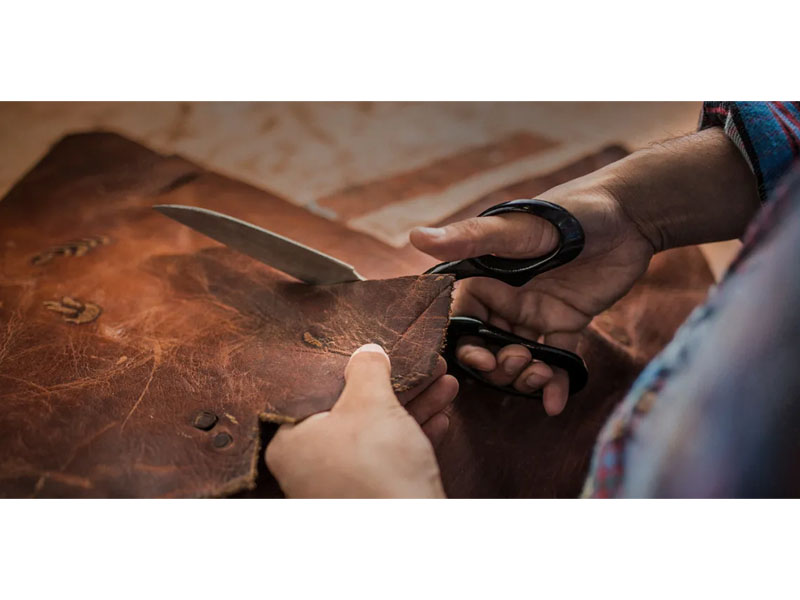
Textile Industry
Many fabrics produced for the textile industry are sanded to obtain a soft surface finish, and we have over a decade of experience in this area.
Browse all FOXWOLL Tools and Hardware Products

Sandpaper FAQ Guide
1. What is sandpaper used for?
2. What sandpaper do you use before painting?
3. What are the different types of sandpaper?
4. What is the strongest sandpaper?
5. How to choose the grit of sandpaper?
6. What is the best sanding grit?
7. Is wet sand better or dry sand better?
8. Can sandpaper be reused?
9. How long will the sandpaper last?
10. Do you need to clean sandpaper?
11. How is sandpaper sold?
12. What sandpaper is best?
13. How to wholesale sandpaper from FOXWOLL?
14. Are there any discounts on FOXWOLL Wholesale sandpaper?
15. How to check the quality of FOXWOLL products?
1. What is sandpaper used for?
Sandpaper is an abrasive material that smooths rough surfaces or removes materials like paint. It is available in various grits, which refers to the size of the particles on the paper. The higher the grit number, the finer the sandpaper.
Some common uses for sandpaper include:
· Sanding down wood before painting or staining
· Removing paint or varnish from wood
· Smoothing out rough surfaces on furniture or cabinets
· Preparing a surface for tile or flooring installation
When using sandpaper, it’s essential to use the correct type of paper for the job.
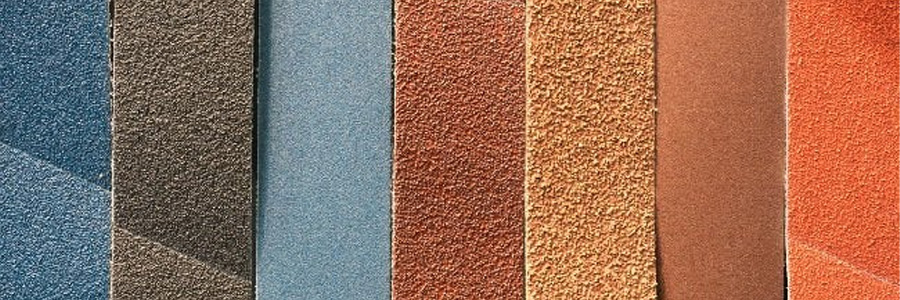
2. What sandpaper do you use before painting?
One of the most critical steps in painting is preparing the surface. This usually involves sanding down the surface to create a smooth base for the paint to adhere to. The type of sandpaper you use will depend on the material you’re painting and the finish you’re looking for.
For wood surfaces, coarse-grit sandpaper is typically used to remove old paint or varnish. Medium-grit sandpaper is then used to smooth out the surface before painting. Fine-grit sandpaper is usually used for metal surfaces to create a smooth finish.
If you’re not sure which type of sandpaper to use, consult a hardware store or the manufacturer of the paint you’re using. They can advise you on the best type of sandpaper for your project.
3. What are the different types of sandpaper?
Different types of sandpaper are available for other purposes. Coarse sandpaper is typically used for rough sanding, while finer grits are better suited for finishing work. In between these two extremes, there are a variety of sandpaper grits that can be used for various tasks.
The following is a breakdown of the different types of sandpaper available and their applications:
Coarse sandpaper (grits ranging from 16 to 24): Coarse sandpaper is ideal for removing paint, varnish, or other finishes from wood. It can also be used for rough sanding bare wood before applying a new finish.
Fine sandpaper (grits ranging from 36 to 60): Fine sandpaper is perfect for smoothing wood that has already been sanded with coarse grit. It can also be used for finishing work on painted or varnished surfaces.
Fantastic sandpaper (grits ranging from 80 to 120): This sandpaper is typically used for final finishing work before applying a sealer or top coat. It can also be used for polishing wood or metal surfaces.
Superfine sandpaper (grits ranging from 150 to 220): Superfine sandpaper is often used for polishing stone or glass surfaces. It can also be used for final finishing work on wood surfaces.
Ultra-fine sandpaper (grits ranging from 240 to 280): Ultra-fine sandpaper is perfect for creating a high-gloss finish on wood or metal surfaces. It can also be used for polishing stone or glass surfaces.
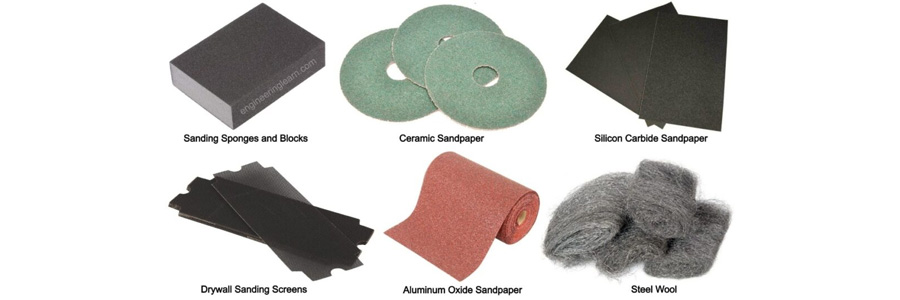
4. What is the strongest sandpaper?
Sandpaper is a type of paper that is coated with an abrasive material. It is used to smooth down surfaces by sanding them. The different kinds of sandpaper vary in the size of their abrasive particles. The larger the particle size, the coarser the sandpaper. Sandpaper with smaller particle sizes is more delicate and is used for finishing work.
There are many different types of sandpaper available on the market. Coarse sandpaper is typically used for rougher jobs, such as removing paint or varnish from wood. Medium-grit sandpaper is suitable for general sanding and can be used on wood and metal surfaces. Fine-grit sandpaper is perfect for finishing work and will give your project a smooth, professional look.
5. How to choose the grit of sandpaper?
Different types of sandpaper are available for other purposes. The type of paper you choose will depend on the task at hand.
Coarse sandpaper is typically used for roughing up surfaces or removing paint. Medium grit sandpaper is suitable for general purpose sanding, and fine grit sandpaper is best for finishing work.
Speciality papers are also available for specific tasks such as wet sanding or working with delicate surfaces.
For stripped wood or metals, you’ll want to start with coarser grit sandpaper and work your way up to a finer grit. If you’re working with sanding wood, you’ll want to start with a medium grit and finish with fine grit.
No matter what the project, be sure to choose the right type of sand. When in doubt, consult a professional to find the right type of sandpaper for your needs.
6. What is the best sanding grit?
The best sanding grits for woodworking projects depend on the type of finish you want. For a smooth, glossy finish, use superfine sandpaper with a determination of 800 or 1,000. For a more matte finish, use sandpaper with a lower grit number.
If you’re working on a woodworking project and you’re not sure what grit sandpaper to use, it’s essential to know that the best grits for achieving different finishes are as follows:
For a smooth, glossy finish: Use superfine sandpaper with a grit of 800 or 1,000.
For a more matte finish: Use sandpaper with a lower grit number.
So, depending on the type of finish you want for your woodworking project, you’ll need to use different grits of sandpaper. Be sure to choose the right one to achieve the look you desire.
7. Is wet sand better or dry sand better?
There is no definitive answer to this question as it depends on the specific project or purpose for which you are using the sand. In general, wet sand is better for packing and molding, while dry sand is better for building and sculpting. If you are working on a project that requires wet and dry sand, it is best to use a mixture of the two.
8. Can sandpaper be reused?
If you’re looking for a way to reuse your sandpaper, a few options are available. You can try using it on a different surface, cleaning it off and storing it correctly, or even recycling it. However, keep in mind that each option has its own set of pros and cons.
One way to reuse sandpaper is by using it on a different surface. This can be helpful if sandpaper is only used on one type of material. For example, if you’ve only used sandpaper to sand down wood, you might not want to use it on metal. However, if you have sandpaper that’s only been used on soft materials like cloth, you might be able to use it on more complex surfaces like stone.
Another way to reuse sandpaper is by cleaning it off and storing it properly. This can help extend your sandpaper’s life and ensure that it’s ready to use the next time you need it. To clean your sandpaper, dampen a cloth with water and wipe it down. Then, store your sandpaper in a cool, dry place from direct sunlight.
Finally, you can also recycle your sandpaper. This is a great way to help reduce waste and keep sandpaper out of landfills. To recycle your sandpaper, cut it into small pieces and add it to your local recycling bin.
Each option has pros and cons, so it’s essential to choose the one that’s right for you. If you’re unsure which option is best, talk to a professional at your local hardware store or home improvement centre. They can help you decide which option is best for your needs.
9. How long will the sandpaper last?
The average lifespan of sandpaper is around three to five years. However, this can vary depending on the type of sandpaper you have, how often you use it, and how well you take care of it. If you use your sandpaper regularly, you may need to replace it more often. On the other hand, if you take good care of your sandpaper, it can last for a more extended period.
To extend the lifespan of your sandpaper, it is essential to store it properly. Make sure to keep the sandpaper in a cool and dry place, away from direct sunlight. You should also avoid storing the sandpaper in humid conditions, as this can cause the paper to degrade.
When not using sandpaper, it is essential to protect it from dust and other debris. You can wrap the sandpaper in a clean cloth or place it in a sealed bag.
If you take proper care of your sandpaper, it can last for many years. However, if you use it frequently or do not store it properly, you may need to replace it more often. When buying sandpaper, be sure to buy from a reputable source to ensure that you get a high-quality product.
10. Do you need to clean sandpaper?
Most people don’t realize that sandpaper can be pretty dirty. Over time, the grit and dust from sanding can accumulate on the paper’s surface, making it less effective. If you’re not careful, this can lead to clogging or gumming up the form. That’s why it’s essential to clean your sandpaper regularly.
There are a few different ways that you can clean sandpaper. One is to rinse it off with water. This will remove any loose grit and dust from the paper’s surface. You can also use a mild detergent and a soft brush to scrub any stubborn dirt.
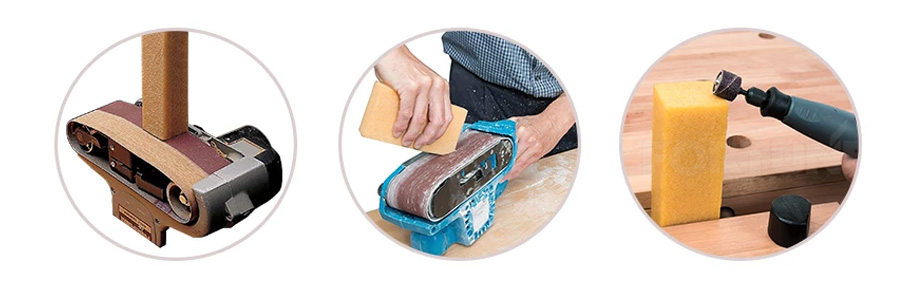
11. How is sandpaper sold?
Sandpaper is typically sold in sheets or rolls. The size of the sheet or registration will vary depending on the type of sandpaper and the intended use. Coarser sandpaper is typically sold in larger sheets or rolls, while finer sandpaper is usually sold in more miniature sheets or rolls. Some sandpaper may also be sold in pre-cut strips or discs. The backing on the sandpaper may also vary, with some sandpaper having a cloth backing and others having a paper backing. The support is typically glued to the abrasive material, although some sandpaper may have a self-adhesive backing.
When purchasing sandpaper, it is important to consider the type of project that will be completed. For example, a coarser sandpaper should be used when sanding a hardwood floor. If sanding a softwood floor, a finer sandpaper should be used. The type of backing on the sandpaper may also be a factor, as some backings are more durable than others. Sandpaper with a cloth backing is typically more expensive than sandpaper with a paper backing, but it will last longer.
It is also important to consider the type of abrasive material on the sandpaper. Aluminum oxide is the most common type of abrasive, but other options include silicon carbide and zirconia alumina. Aluminum oxide is typically the best choice for general-purpose sanding, while silicon carbide is better for more challenging applications.
12. What sandpaper is best?
There are many different types of sandpaper on the market, and it can be tough to decide which one is best for your needs. If you’re not sure what kind of sandpaper to get, here’s a quick guide to help you make the best decision.
The first thing you need to consider is the type of material you’ll be sanding. Sandpaper comes in different grits, or coarseness levels, and each one is better suited for different materials. For example, coarse sandpaper (with a lower grit number) is good for removing paint or varnish from wood, while fine sandpaper (with a higher grit number) is better for sanding softer materials like aluminum or plastic.
13. How to wholesale sandpaper from FOXWOLL?
To get sandpaper from FOXWOLL, you have two options. The first option is for finished orders which require confirmation of contract and payment after factory production; while customization needs to send in design before confirming any obligations with them later on down the line (which also ensures quality).
14. Are there any discounts on FOXWOLL Wholesale sandpaper?
We know you want the best for your business, which means providing our customers with the value they can’t find anywhere else. That’s why we offer new customer discounts as well!
15. How to check the quality of FOXWOLL products?
We believe that quality is the most important thing in business. We have a team of quality inspectors who check each and every product for any signs that it isn’t up to snuff. We offer free samples before shipping so you can be confident in your purchase!

